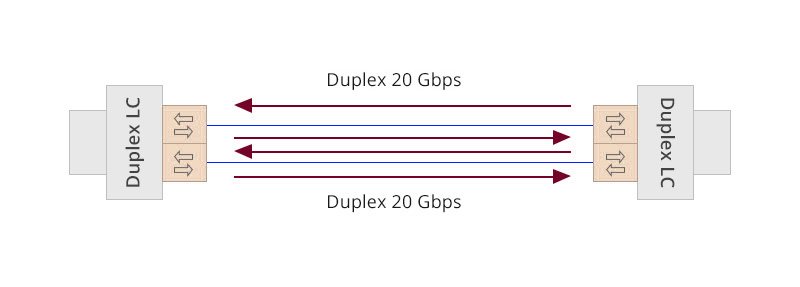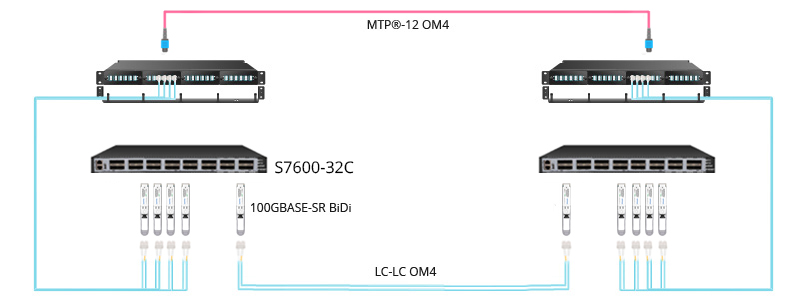40G vs. 100G BiDi Transceivers, What is The Difference
40G and 100G BiDi optical modules As data traffic grows, the growing demand for higher capacity and superior bandwidth performance in data centers and IT infrastructure has become a cost-effective solution to optimize fiber cable utilization and promote data center deployment. This blog post will introduce these two BiDi optical modules in depth.
The Overview of 40G And 100G BiDi Transceiver
Before the introduction of 40G and 100G bidirectional (BiDi) optical modules, most data centers chose to use 40GBASE-SR4 optical modules for short-distance transmission over multimode fiber (MMF) via MPO/MTP connectors. In this case, operators must replace existing LC MMF patch cords with MPO MMF optical cables and introduce additional optical fibers into their optical cable infrastructure. This often leads to various outages, complicates the upgrade process, and increases the costs associated with optical cable management and configuration. However, 40G and 100G BiDi optical modules can send and receive data simultaneously over one optical fiber, achieving the same transmission distance as SR4, effectively solving challenges such as the need to replace existing optical fiber facilities and optical fiber resource utilization. In addition to these advantages, 40G and 100G BiDi optical modules have other advantages.
Easy Management: These transceivers enable operators to reuse existing MMF cable infrastructure, including patch cords, panels, and fiber trunks. Moreover, they simultaneously utilize a single port for transmitting and receiving optical signals at different wavelengths, simplifying deployment and management.
Cost Savings: 40G and 100G BiDi transceivers require fewer optical fibers and fiber patch panels than SR4 transceivers, offering a more cost-effective solution for data center deployments.
Time Efficiency: Adopting 40G and 100G BiDi transceivers eliminates the need for operators to add new optical cables to the fiber infrastructure. Consequently, network deployment times are shorter compared to traditional optical transceivers.
Different Types of BiDi Transceivers
BiDi modules, with their unique advantages, have been widely adopted in data centers, encompassing various speeds such as 1Gbps, 10Gbps, 25Gbps, 40G QSFP+ BiDi transceivers, and 100G QSFP28 BiDi transceivers. This article primarily focuses on the latter two.
40G QSFP+ BiDi Transceivers
The 40G BiDi transceiver features two 20G signal channels, allowing simultaneous transmission and reception of two wavelengths over a single multimode fiber (MMF). It achieves a transmission distance of up to 100m for OM3 and 150m for OM4. Distinguishing itself from other 40G optical transceivers, the 40G BiDi transceiver is equipped with critical electronic components such as WDM couplers. This enables the transceiver to combine and separate data on a single optical fiber based on the wavelength of light.
Moreover, the 40G BiDi transceiver can reconfigure the existing 10G cabling structure to support 40G network connectivity, providing an easy-to-deploy and manage solution. In addition to its ease of deployment, the 40G BiDi transceiver boasts high performance, cost-effectiveness, and high density, making it an ideal choice for cloud, enterprise, and data center environments.

100G QSFP28 BiDi Transceivers
Like other BiDi transceivers, the 100G BiDi transceiver also supports bidirectional data transmission and reception over a single fiber, allowing the reuse of existing duplex LC MMF fiber infrastructure. However, it facilitates communication at a speed of 100G, effectively doubling the data transmission capacity.
Furthermore, the 100G BiDi transceiver is specifically designed for use in 100GBASE Ethernet with throughput capabilities of up to 70m with OM3, 100m with OM4, and 150m with OM5 MMF. It operates at 850nm and 900nm wavelengths through a duplex LC connector. Typically deployed for 100GE Ethernet connectivity, data center deployment, and High-Performance Computing (HPC), it presents a cost-effective solution for network capacity upgrades.

The Difference Between QSFP 40G SR BD and 100G SR BiDi
Data Rate: The primary distinction between the optical modules is their data speed. While the QSFP SR BD boasts a data rate of 40 Gbps, the 100G SR BiDi provides a significantly higher data rate up to 100 Gbps. This disparity in data rates enables the latter to handle more substantial volumes of data at any given time, making it well-suited for bandwidth-intensive applications that demand swift data transmission.
Cost: Cost considerations often play a pivotal role in decision-making. Generally, QSFP 40G SR BD modules are more economical than their 100G SR BiDi counterparts. The lower data rate of the 40G module contributes to this price difference. Businesses operating within budget constraints may find QSFP 40G SR BD modules to be a prudent investment.
Fiber Compatibility: Both modules are designed for multimode optical fibers, commonly employed in data centers. However, there is a slight discrepancy in fiber compatibility. While the QSFP 40G SR BD is compatible with OM3 and OM4 multimode fibers, the 100G SR BiDi necessitates OM4 multimode fiber due to its higher bandwidth requirements. When selecting the appropriate module for your network, ensuring compatibility with the fiber type is crucial.
Performance: The choice between these modules should align with the specific performance requirements of your network. Given its lower data rate, the 40G SR BD module is suitable for scenarios where achieving high bandwidth is not the primary focus.
Conversely, the 100G SR BiDi variant is purpose-built to address bandwidth-intensive applications that demand enhanced data throughput capabilities. This technology excels when rapid data transfer is crucial, particularly in data center environments with heavy workloads.
Future-Proofing: Anticipating future needs is a critical consideration in network infrastructure decisions. If the data rate requirements of your network increase over time, the QSFP 40G SR BD may necessitate future upgrades.
On the other hand, the alternative option provides a higher data rate, potentially meeting future data demands without requiring immediate module replacement. And this scalability can be a significant advantage for businesses preparing for future expansion and technological advancements.
Heat Dissipation: The heat generated by optical modules can impact a data center's overall operating conditions. Due to their lower data rate, QSFP SR BD modules emit less heat than 100G SR BiDi modules. Consider your data center's cooling infrastructure and power efficiency goals when evaluating heat dissipation characteristics.
The Application of QSFP 40G SR BD and QSFP28 100G SR BD
The adoption of 40G and 100G BiDi transceivers is rising, particularly in data centers. This trend is driven by their ability to provide cost-effective solutions and facilitate network upgrades without replacing the existing fiber optic cable infrastructure. The following outlines the functionality of 40G and 100G BiDi transceivers in achieving 40G and 100G network connectivity.
The Application of QSFP 40G SR BD
In the depicted 40G network deployment, illustrated in the figure below, the 40G S7300-48X2Q4C enterprise switch establishes a connection with the S7600-24X2Q data center switch using LC to LC OM3 cables and MTP-12 OM4. The 40G ports are linked to the QSFP-40G-SR BiDi transceivers. This configuration enables the establishment of a high-performance and cost-effective 40G network connection.

The Application of QSFP28 100G SR BD
The figure below illustrates that two 100G S7600-32C data center switches establish a connection using LC-LC OM4 cables and 100GBASE-SR BiDi transceivers. With a transmission distance of up to 100m, this configuration achieves seamless 100G network connectivity.

The Application of Dual-Rate 40G/100G BiDi Transceiver
Apart from the 40G above and 100G BiDi transceivers, the dual-rate 40G/100G BiDi transceiver is crucial in deploying data centers, particularly in leaf-spine network architecture setups (as depicted in the image below). Due to their support for both 40G mode and 100G mode network connectivity, 40G/100G BiDi transceivers offer enterprises a range of cost-effective and flexible options for network migration and upgrades. Additionally, these transceivers employ PAM4 and onboard forward error correction (FEC) technologies, significantly enhancing data transmission efficiency.

Conclusion
In summary, when choosing between QSFP 40G SR BD and 100G SR BiDi optical modules, consider your network's current data rate needs, budget constraints, and compatibility with existing infrastructure. Opt for the 100G SR BiDi module if your network demands enhanced bandwidth and scalability and is equipped with the necessary infrastructure for bandwidth-intensive applications. On the other hand, if cost-effectiveness and moderate data speeds are priorities for your network, the QSFP 40G SR BD module may be a more economical choice, particularly for short-distance connections within data centers or corporate environments. QSFPTEK provides high-quality and low-price 40G & 100G SR BD transceivers; feel free to consult us via [email protected].












